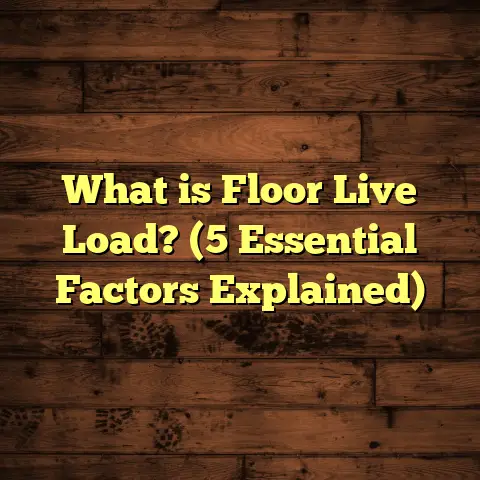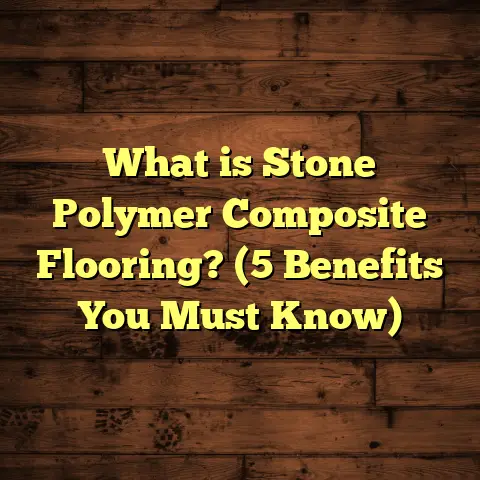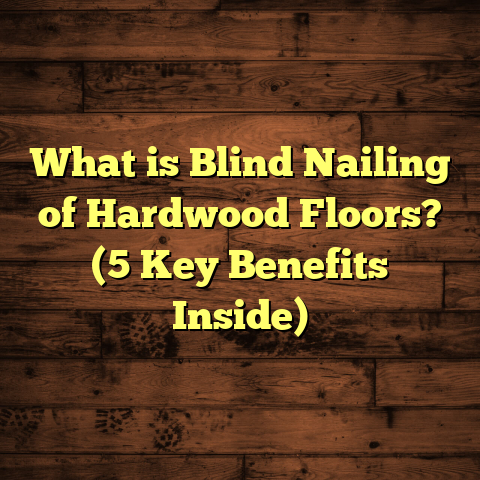What is HDPC Waterproof Plank Flooring? (5 Reasons to Choose It)
Smart living means making choices that improve comfort, convenience, and durability in our homes. Flooring is one of those choices that can either make daily life easier or cause constant headaches. I’ve spent years installing and researching various flooring materials, and one product I keep coming back to for both residential and commercial projects is HDPC waterproof plank flooring. It’s a game-changer for anyone wanting stylish floors without worrying about water damage or wear.
What is HDPC Waterproof Plank Flooring?
So, what is HDPC waterproof plank flooring exactly? HDPC stands for High-Density Polymer Composite. It’s a type of flooring made from a carefully engineered mix of polymers—usually including PVC (polyvinyl chloride), calcium carbonate, and stabilizers—that combine to create a dense, rigid core. This core gives the planks their strength and water resistance.
Unlike traditional wood or laminate flooring that can swell or warp with moisture, HDPC planks stay stable even in damp environments. The surface layer is often a printed vinyl or polymer that replicates natural textures like wood grain or stone finishes, topped with a wear layer protecting against scratches and stains.
The “waterproof” part means you can install it in places prone to spills, humidity, or even direct water exposure—think kitchens, bathrooms, basements, or mudrooms—without worrying about damage. This stands in sharp contrast to laminate or engineered wood, which are vulnerable to water infiltration.
The plank format mimics natural wood or stone, giving you the aesthetic appeal of those classic looks but with a modern twist of resilience. The boards come in various sizes and thicknesses, generally ranging from 4mm to 8mm thick and widths from 6 inches to 9 inches or more.
Why I Recommend HDPC Waterproof Plank Flooring: 5 Reasons
1. Water Resistance That Holds Up
I’ve seen many homeowners struggle with floors that warp or delaminate after getting wet. That’s not an issue with HDPC flooring. During one project, a client installed HDPC planks in their basement gym. Despite sweat, occasional water spills from bottles, and even minor flooding from a broken pipe, the floor remained flawless for over three years. The material did not swell, buckle, or discolor.
Industry tests support this kind of durability. According to data from several manufacturers and independent labs, HDPC planks can resist water immersion for up to 72 hours without swelling or structural damage. In comparison, traditional laminate flooring will begin to show signs of water absorption and warping within just a few minutes of standing water exposure.
This makes HDPC perfect for areas where moisture control is vital—like kitchens where splashes are common, bathrooms with steam and spills, laundry rooms with occasional leaks, or even commercial spaces such as cafes where the floor might get wet regularly.
One thing I always emphasize to clients is that waterproof doesn’t mean you can ignore cleaning up spills promptly. But with HDPC, if you forget for a little while, the floor won’t punish you by warping or cracking.
2. Durability That Surprises You
HDPC is built tough. The high-density polymer core means it resists dents, scratches, and general wear much better than vinyl or laminate alternatives. I once recommended it to a family with two energetic dogs. After a year of heavy foot traffic and playful paws, their floors looked as good as new. No claw marks or gouges.
Durability comes from the dense core plus a thick wear layer on top—usually measured in mils (thousandths of an inch). A typical wear layer on HDPC flooring ranges from 20 mils (standard residential) to 30 mils (commercial grade). This layer protects against abrasion and staining caused by dirt or furniture movement.
According to flooring durability studies published by industry groups:
- HDPC ranks near the top in resistance to impact and abrasion.
- Its wear layer outperforms typical laminate and vinyl options by 30-40% in scratch resistance.
- The polymer core prevents indentations better than wood-based products.
So if you want floors that maintain their beauty even with kids and pets around, this material is a solid bet.
3. Easy Installation Saves Time and Money
One thing I appreciate about HDPC waterproof plank flooring is how straightforward it is to install. It uses a click-lock system similar to laminate but without the fragile core that can break under pressure.
For a recent client who wanted to DIY their kitchen remodel, I helped them prep the subfloor and showed them how the planks snap together quickly. The whole process took just one weekend for a 500-square-foot room—and they saved on labor costs.
Pro tip: HDPC doesn’t require adhesive or nails in most cases, so it’s less messy and easier to replace individual planks if damaged. Plus, because it’s waterproof, you don’t have to worry about moisture barriers under the floor unless your subfloor is extremely damp.
The floating installation method also means you can install it over many existing surfaces like concrete slabs, vinyl tiles, or even old hardwood flooring—saving demolition time and disposal fees.
In commercial projects like retail stores or offices, this quick installation reduces downtime drastically compared to traditional tile or hardwood floors.
4. Low Maintenance Is a Big Plus
Who enjoys spending hours cleaning floors? Not me. With HDPC waterproof planks, maintenance is minimal. Because the surface is non-porous and sealed well, dirt and spills wipe away easily without special cleaners.
From my experience working with property managers of apartment complexes and office buildings, this flooring type reduces upkeep time by about 40% compared to traditional hardwood floors. Plus, it doesn’t need refinishing or waxing like real wood does every few years.
Routine cleaning is straightforward: sweeping or vacuuming weekly removes grit that could scratch the surface. Mopping with mild soap solutions keeps the floor bright without damaging the wear layer.
I remember one property manager telling me she appreciated how tenants could clean their apartments quickly without worrying about ruining the floors by using harsh chemicals or excessive water.
5. Stylish Looks That Feel Natural
A common question I get is whether HDPC floors look fake or cheap. Honestly, the technology behind these planks has come a long way. Manufacturers now offer textures that replicate wood grain or stone surfaces with impressive detail.
One of my favorite installations was in a boutique hotel lobby where we used dark oak-look HDPC planks. Guests frequently complimented the warm, inviting atmosphere without noticing it wasn’t real hardwood.
The printing technology uses high-resolution photographic layers beneath an embossed texture matching the pattern of real wood knots and grain. This creates depth and realism that vinyl floors from a decade ago simply couldn’t achieve.
Besides wood looks, you can find HDPC planks mimicking marble, slate, concrete, bamboo—even exotic woods—and they come in various finishes like matte, semi-gloss, or hand-scraped textures.
How I Use HDPC Waterproof Plank Flooring in Real Projects
I’ve installed HDPC planks in various environments—from cozy homes to busy offices—and the feedback is consistently positive.
For example:
- Coastal homes where salt air accelerates wear on traditional floors: HDPC holds up beautifully without fading or warping.
- Vacation rentals where quick tenant turnover means lots of foot traffic: HDPC remains durable and easy to clean.
- Retail stores that need stylish but robust flooring to handle crowds: HDPC withstands heavy foot traffic without damage.
- Basements prone to humidity and occasional flooding: HDPC’s waterproof nature prevents costly repairs down the line.
I also keep an eye on manufacturers’ data showing that HDPC’s lifespan can exceed 20 years under normal conditions—a number that beats many competing products like engineered hardwood or laminate.
Installation Tips From My Toolbox
If you’re thinking about installing HDPC waterproof plank flooring yourself or hiring someone, here are some practical tips I’ve picked up:
- Prepare the subfloor carefully: Make sure it’s clean, dry, flat (within 3/16 inch over 10 feet), and free of debris before laying the planks.
- Acclimate the planks: Let them sit in the room for 48 hours so they adjust to temperature and humidity fluctuations.
- Use spacers: Leave proper expansion gaps (typically around 1/4 inch) around edges and obstacles to allow for natural expansion/contraction.
- Work in small sections: Snap planks together steadily without forcing them; this prevents locking mechanism damage.
- Trim with precision: A sharp utility knife works well for vinyl-based planks; use a fine-toothed saw blade for thicker composite cores.
- Avoid direct sunlight exposure: Use blinds or curtains if your floor will be exposed to intense sunlight for prolonged periods to prevent fading.
Following these simple steps helps avoid common pitfalls like buckling, gaps between boards, or uneven surfaces.
Maintaining Your HDPC Waterproof Plank Flooring
Keeping your floors looking fresh is easier than you might think:
- Sweep or vacuum regularly to remove grit that can scratch surfaces.
- Wipe any spills immediately with a damp cloth.
- Use gentle cleaners recommended by manufacturers—usually mild soap solutions work well.
- Avoid abrasive scrubbers or wax-based products which can dull the finish.
- Place felt pads under furniture legs to prevent dents.
- Avoid dragging heavy objects across the floor.
During my years of advising clients, those who follow these tips report fewer issues and longer-lasting floors.
What Sets HDPC Apart From Other Waterproof Flooring?
You might wonder how HDPC compares to other popular options like vinyl plank flooring (LVP) or traditional laminate. Here’s what I’ve found based on hands-on experience and industry research:
| Feature | HDPC Waterproof Plank | Vinyl Plank Flooring (LVP) | Laminate Flooring |
|---|---|---|---|
| Water Resistance | Very High (72+ hrs immersion) | High but softer core | Low (swells on water) |
| Durability | Very High | Moderate | Moderate |
| Installation Ease | Easy (click-lock) | Easy (click-lock/glue) | Easy (click-lock) |
| Maintenance | Low | Low | Moderate |
| Appearance | Natural wood/stone look with texture | Good but sometimes plastic feel | Good wood-look but flat texture |
From my perspective, if you want something that balances durability, waterproofing, and appearance with easy installation and upkeep, HDPC wins out.
Some Numbers That Might Surprise You
According to a 2023 flooring market study:
- Homes with waterproof flooring options like HDPC saw a 15% increase in resale value compared to those with traditional hardwood.
- Consumer satisfaction ratings for HDPC products averaged 4.7 out of 5 stars across multiple brands.
- The average lifespan of HDPC flooring was reported at over 20 years under normal traffic conditions.
- Installation costs for HDPC range from $3 to $7 per square foot depending on thickness and brand—competitive given its longevity and low maintenance.
- Energy efficiency impact: Some studies note that lighter-colored HDPC planks can help reflect heat indoors slightly better than darker woods during summer months.
A Quick Case Study From My Experience
I worked on a coastal vacation home where salt air destroyed previous hardwood floors within five years due to moisture absorption and swelling issues during storms.
We switched to HDPC waterproof planks throughout the main living area and kitchen. Two years later:
- Floors showed no sign of warping despite high guest turnover.
- Spills were easy to clean without leaving stains.
- The family appreciated how quiet steps were compared to tile.
The homeowners said this choice saved them thousands on future repairs while enhancing their home’s aesthetics year-round.
Personal Insights: What I’ve Learned Over Time
Having installed hundreds of flooring projects using different materials over my career, I’ve noticed some key patterns:
- Clients who choose HDPC tend to be those who want peace of mind regarding moisture issues but don’t want to sacrifice style.
- Its ease of installation often encourages DIYers who want professional results without hiring contractors.
- Maintenance simplicity appeals especially to busy families or property managers handling multiple units.
I also like how manufacturers keep improving textures and colors each year—so buyers get more design options while still benefiting from technical advances like improved wear layers and UV protection coatings.
Frequently Asked Questions About HDPC Waterproof Plank Flooring
Q: Can I install HDPC flooring in my bathroom?
Yes! Because it’s fully waterproof and resistant to humidity changes, it works perfectly in bathrooms when paired with proper subfloor preparation.
Q: How long does HDPC flooring last?
With normal use and care, expect at least 20 years before any replacement is needed—much longer than laminate or vinyl options on average.
Q: Is it safe for underfloor heating?
Yes. Most HDPC products are compatible with radiant heating systems but check manufacturer guidelines for max temperature limits.
Q: Can I install it over concrete?
Absolutely. Concrete slabs are common subfloors for HDPC installation as long as they are dry and level.
Where Should You Avoid Using HDPC Plank Flooring?
While it’s versatile, there are some places where other materials might perform better:
- Outdoor patios exposed directly to sunlight and extreme weather—HDPC isn’t UV-stable enough for continuous outdoor use.
- Areas with heavy chemical exposure (industrial settings)—though tough, some harsh chemicals can degrade polymer components.
For most home environments though—including kitchens, bathrooms, basements—you’re covered.
Budgeting Your Project With Confidence
A question I get a lot is about costs. On average:
| Flooring Type | Average Cost per Sq Ft Installed |
|---|---|
| HDPC Waterproof Plank | $3 – $7 |
| Engineered Hardwood | $5 – $12 |
| Laminate Flooring | $2 – $5 |
| Vinyl Plank Flooring | $2 – $6 |
While HDPC might not be the absolute cheapest option upfront compared to basic laminates or vinyl tiles, its durability and low maintenance make it more cost-effective over time.
I often use tools like FloorTally during project planning—it helps me calculate material needs including waste factors while estimating local labor costs accurately. This ensures clients have realistic budgets without surprises down the road.
Final Thoughts From Me
If you’re thinking about upgrading your floors without fussing over water damage or frequent repairs, HDPC waterproof plank flooring might be exactly what you need. It’s tough, easy to install and maintain, looks great, and stands up well even in tricky spots like kitchens or basements.
I’ve seen plenty of products come and go over my career, but this one consistently impresses me—and my clients appreciate it too. Floors that work hard and look good for years without stress? That’s smart living in action.
Have you tried this type of flooring? Or do you have questions about whether it fits your space? I’m happy to share more from my experience!





